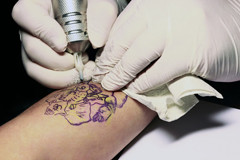Tattoos and infection: Think before you ink

ARCHIVED CONTENT: As a service to our readers, Harvard Health Publishing provides access to our library of archived content. Please note the date each article was posted or last reviewed. No content on this site, regardless of date, should ever be used as a substitute for direct medical advice from your doctor or other qualified clinician.
My friend Monica had a teacher in high-school who repeatedly told his students to "think before you ink." In the days before personal computers and word processors, he was urging them to know what they wanted to say before committing it to paper. Today, "think before you ink" has a far different meaning. It's an exhortation to ponder the implications, and the safety, of getting a tattoo.
A report in this week's Journal of the American Medical Association describes an outbreak of tattoo-related infections in four states: New York, Washington, Iowa, and Colorado. All involved Mycobacterium bacteria. Infection with these fast-growing bugs can cause problems ranging from a mild rash around the tattoo site to severe abscesses that require surgery and several months of antibiotic therapy.
"Tattoo-related infections aren't common, but they do happen," says Dr. Daihung Do, an instructor in dermatology at Harvard Medical School and director of cosmetic and laser surgery at Beth Israel Deaconess Medical Center. "They can take various forms—I once saw a patient who developed warts as a result of a tattoo."
Complications happen
Once the emblem of sailors and biker gangs, tattoos have moved into the mainstream. Depending on the survey, 20% to 40% of adult Americans have one or more tattoos. In addition plenty of teens and twenty-somethings, I've seen them on new moms and dads and grandmothers. They are becoming accepted in the workplace.
With all this tattooing going on, complications are bound to occur. The infection outbreaks described in JAMA aren't the first such report. One in Ohio, Kentucky, and Vermont involved methicillin-resistant Staphylococcus aureus (sometimes known as MRSA), a hard-to-treat bug that can cause substantial damage to the skin and the rest of the body. The possibility exists that tattooing can transmit even more harmful microbes, such as the viruses that cause hepatitis or AIDS, but there is little evidence of this actually happening.
Tattoo-related infections have two main sources:
The artist and his or her studio. A tattoo artist that doesn't use sterile techniques can spread bacteria or other infectious organisms. Sterile technique means sterilizing tools, washing hands and using gloves, and using sterilized water when tattoo ink must be diluted. Some states, counties, or cities have set standards for tattoo artists and their studios; others haven't.
Tattoo ink. The FDA considers tattoo ink to be a cosmetic product. Although it is supposed to approve these inks before they can be marketed, "because of other competing public health priorities and a previous lack of evidence of safety problems specifically associated with these pigments, FDA traditionally has not exercised regulatory authority for color additives on the pigments used in tattoo inks." In other words, it only responds if a problem occurs.
This spotty oversight of tattoo artists, studios, and inks is a bit scary given the explosion in the popularity of tattoos, and the fact that a tattoo is essentially a puncture wound made deep into the skin that is filled with ink.
Safe tattooing
Most people who get a tattoo come through the procedure with the design they desire and nothing more. It's a testament to the safe practices of some tattoo artists and to the ability of the human body to resist infection.
Here are a few tips for before and during tattooing to help prevent infection:
- Contact your state department of public healthto find out if tattoo artists and their studios must be licensed or registered in your state. You may also be able to get from your local health department a list of licensed or registered shops as well as any complaints that have been filed.
- Ask your artist directly what the shop's sterilization processes are. The shop should have an autoclave—a device for sterilizing equipment.
- Make sure the artist uses a new, sterile needle with every tattoo, and wears a new pair of gloves.
After-care
Taking care of your skin immediately after getting a tattoo can both prevent infection and help keep it looking great. While specific instructions vary from shop to shop, here are the basics, courtesy of Fat Ram's Pumpkin Tattoo in Jamaica Plain, MA (my local tattoo studio):
- After a tattoo session is over, take off the bandage within three to five hours. Wash your hands with antibacterial soap and warm water, then wash the tattooed skin. Pat dry with a paper towel or clean cloth towel.
- Allow the skin to air dry for 5 to 10 minutes. Then apply a very thin layer of Vaseline, Aquaphor, or other ointment.
- Repeat the washing, drying, and moisturizing process three to four times a day for four days.
- When the tattooed skin starts to shed a thin flaky layer of skin, do not scratch or pick at it. At this point you can switch to a moisturizer—don't let your tattoo get dried out for the first few weeks.
- Call your doctor—not the tattoo artist—if redness or swelling persists after a few days, you have a fever, or you notice a rash in or around the tattoo.
Moving on
Some people who get a tattoo will keep it forever. Others change their minds and want it removed. While it's possible to have a tattoo removed, it isn't easy. I'll take a look at the process in a future post. If you have a story about having a tattoo removed, good or bad, let me know at hhp_blog@hms.harvard.edu.
About the Author

Patrick J. Skerrett, Former Executive Editor, Harvard Health Publishing
Disclaimer:
As a service to our readers, Harvard Health Publishing provides access to our library of archived content. Please note the date of last review or update on all articles.
No content on this site, regardless of date, should ever be used as a substitute for direct medical advice from your doctor or other qualified clinician.












